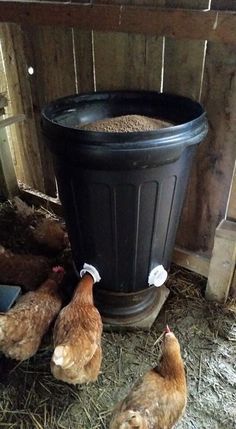Brilliant feed bin idea. No scrapping around or wasted feed on the floor. And the feed stays dry in the rain.
-
 I bought this $5500 ... 4 months ago
I bought this $5500 ... 4 months ago -
 This Innovative Prod... 5 months ago
This Innovative Prod... 5 months ago -
Secret Tiny Home �... 5 months ago
-
 Tiny House Design 1 ... 5 months ago
Tiny House Design 1 ... 5 months ago -
 Chicken Earrings Egg... 5 months ago
Chicken Earrings Egg... 5 months ago -
 How Texas Homesteade... 5 months ago
How Texas Homesteade... 5 months ago
About us
Goodshomedesign is an online home design magazine but do not sell the products reviewed or showcased on this site. We try to show you what is new and beautiful in this area, arranged in several categories (apartments, ideas, interior design, home decor, home design, kitchen, bedroom, bathroom, furniture, hotels & resorts, architecture) related to the area and style.
Friends & Partners
Submit your work
Want to publish your own work?! Show us what you’ve got! We would love to check out the personal work created by any of our amazing fans. If you really have something good, we will publish it with your own name in our online magazine.
© 2025 Home Design, Garden & Architecture Blog Magazine. All rights reserved.












I’ll never cease to be amazed at the uses for PVC piping. The steps in picture format is very useful, too. Nice and easy to follow.
This is brilliant, but the vinyl chloride in PVC is a known carcinogen. Therefore, PVC use in anything to do with chicken husbandry is counterintuitive & counterproductive to those raising their own chickens for the sake of a cleaner, greener, healthier food source.
The chickens aren’t eating the PVC they are eating out of it. Almost every house in the mid west has PVC water piping from the meter to the house with no harmful effects. So let the chickens eat out of it. It is safe.
Has talking about the possibilities of releasing cancer related chemicals according to the temperature exposure of the PVC (hot or cold). Whether you own a home or rent if you use hot water and run it thru PVC chances are you are bathing in harmful chemicals.
How do you know there are no ‘harmful effects’ in using PVC, or even the glue used to put the feeders together? I really like the idea of these feeders… easy to build… but I won’t use PVC to make them for the same reason YTG137 stated.
Just so you know… my household water is filtered… for the same reason.
Better check- your filter housings are probably plastic as well. And whatever factory processed the chicken feed is probably using a variety of plastics. I think you’re chasing ghosts.
I would like to know what kind of filter that you could have in your household would filter out these kind of contaminants. Maybe a very expensive reverse osmosis system…
Using drinking water PVC is safe. Using sewer PVC is not. Need the “food” grade PVC which is labeled for carrying drinking water.
Thank you so much for the complete how to… I’m planning to put this in our new coop.
Thank you so much for the complete how to… I’m planning to put this in our new coop.
I agree after reading what the EPA has published about it. I will build a safer alternative.
Make sure these are under cover from the rain. They look great when they are dry but once water gets in the food everything gets wet and the feed quits flowing. I like the hanging feed container hanging inside where I can fill it without getting me or the feed wet. Just my thoughts from 27 years of backyard chickens.
I’ve heard of them sweating and molding. is this a factual thing or no? Asking for a friend who has chickens.
Your drinking water comes through these same types of pipes.
What about using 1″ PEX instead?
I like the idea of this. The addition of the ‘low feed’ flag in the linked article is a great one also and one I haven’t seen before on other blogs.
how many would I need for 6 chickens?
amazinf
Our water bottles and plastic ware that we use all contain chemicals that may cause some kind of harmful effect to us. So what’s the differense? Even the foods we eat contain some kind of harmful chemicals.
I’d caution using these. I have the same design and have lost at least 2 young chickens because they try to crawl up into the tube as it gets empty and they get stuck. I’m installing wire over the opening so they can’t enter.